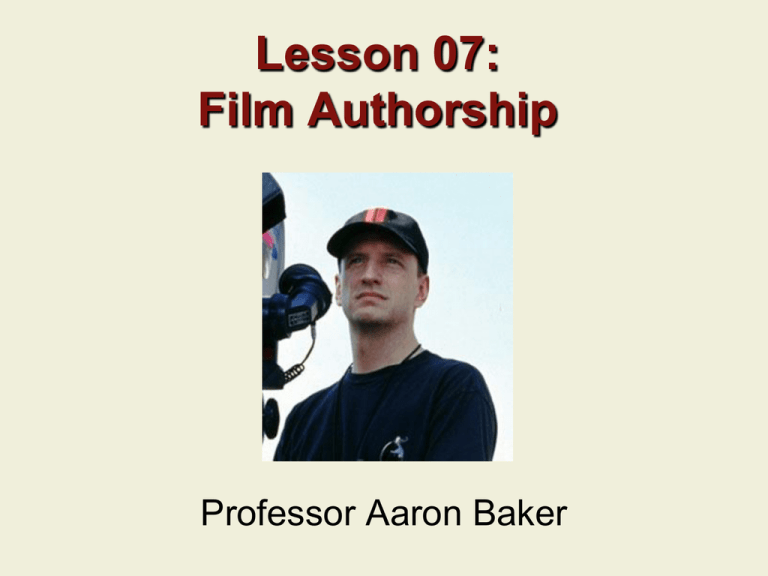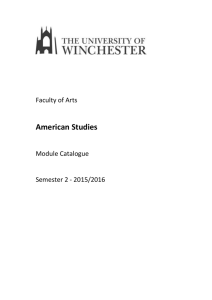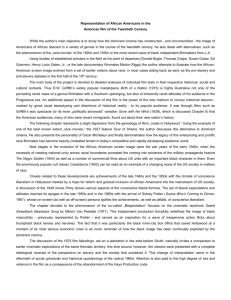Film Authorship
advertisement

Lesson 07: Film Authorship Professor Aaron Baker Previous Lecture • • • • Film Genre The Gangster Film Goodfellas (1990) Corrected Genre Film: -Entertainment and Social Critique 2 Today’s Lecture • Approaches to Film Authorship • Steven Soderbergh’s Film Traffic (2000) 3 Part I: Approaches to Authorship 4 Auteurism • Auteur = Author • Post WW II French Cultural Formation: -Magazines, Festivals, Cinemateque, Cine Clubs • Existentialism -Absurd World -Individual Recreates It HENRI LANGLOIS, CO-FOUNDER OF CINEMATHEQUE FRANÇAISE in Paris in 1936, the world’s first film archive. 5 Film is Art • • • • • Alexander Astruc French Director, Critic Camera Stylo (Pen) Filmmaker Like Writer Films Like Novels, Poems, Plays 6 Parisian Critics • Andre Bazin, Francois Truffaut, Jean Luc Godard • Reject French Cinema of Quality • Too Literary, Elitist • Prefer Hollywood Energy, Lack of Pretention 7 Style • Reveals “Personality” (View of World) • Metteurs (Conventional) vs. • Auteurs (Innovative) 8 Auteurism Combines: • Idea of Romantic Artist (Individual, Outsider) • Modernist Focus on Form, Style • Post Modern Celebration of Popular Culture 9 French Auteurist Critics Ambivalence Toward Hollywood: -Like Hollywood Energy, Lack Pretention -Dislike Obsession with Profits Over Art, Society On the set of Le Mepris (1963) 10 American Critic Andrew Sarris • Brought French Auteurism to U.S. • Notes on The Auteur Theory (1962) • U.S. Films Best in World • Great Hollywood Directors Transcend Studio System • Pantheon 11 Andrew Bazin: “The individual transcends society, but society is also . . . within him. So there can be no criticism of genius or talent which does not take into consideration the social determinism.” 12 Genius Peter Lehman and William Luhr write: “The concept of an author as a genius outside history, who possesses profound, universal insights, . . .is now . . . outdated” (Thinking About Movies, p. 77). 13 Talent and Context It’s most useful to recognize: • A director’s individual talent • The cultural and social environments in which s/he works. 14 Style and Race • Spike Lee has made films with a distinctive viewpoint and formal style • They have been influenced by ideas of race in the movie industry and within American society. 15 John Ford • • • • • Stagecoach (1939) Native Americans as “Savages” Cheyenne Autumn (1964) New Ideas of Race in American Society Shows Abuse of Native Americans by Whites 16 Collaboration While films often involve the contributions of many people, a skilled director can have the greatest input in shaping and organizing what a film becomes. Themes and Style Analysis of film authorship starts with: • The thematic concerns and • Formal style of the moviemaker 18 Style in Steven Spielberg’s Films His films often combine special effects portrayal of the fantastic . . . 19 Thematic Patterns “With family dramas of divorce, singleparent homes, and the precarious formation of romantic couples.” (Lehman and Luhr, p. 80). Catch Me If You Can (2002) 20 Part II: Steven Soderbergh 21 Steven Soderbergh Tells stories about: • Social problems • Outsider characters • Through allusions to other films • Discontinuity editing • Handheld camera 22 Scene from Traffic (2000) -Mexican cop (Benicio Del Toro) goes outside law to stop drug cartel. -Corrupt General killed. -Handheld Camera -Discontinuity Editing -Please view the clip. 23 Continuity and Change Analysis of a director’s films can show: • Thematic and formal Continuity Or • Change over the period of her/his career 24 Alfred Hitchcock Went from tasteful suspense in North By Northwest (1959) to. . . 25 Graphic Horror In Psycho the following year, 1960. 26 Soderbergh • Started Making Independent and Art Films: -Sex, Lies and Videotape (1989) -Kafka (1991) -King of the Hill (1993) • Moved to mix of Blockbuster, genre films w/ stars: -Erin Brockovich (2000) -Ocean’s series (2001-7) • And smaller budget, challenging films: -Bubble (2005) -Che (2008) 27 Patterns of Continuity • But even Soderbergh’s commercial films (Ocean’s series) show political and formal concerns of his art/independent movies: -Social Injustice -Mix Realism and Stylized Form 28 Outsiders and Not an Invisible Formal Style! • Thieves Target Greedy Casino Owner • Introduced with: -Stylized Editing -Hand Held Camera -Music That Helps Define Their Cool • Please view the clip. 29 Intention • The meaning we experience from a director’s films isn’t always intended by the filmmaker. • Valid meaning can come from critical analysis as well as the conscious creation of the filmmaker. 30 Alfred Hitchcock • Saw himself as a master of suspense. • Psychoanalytic criticism has made convincing case for unconscious fear in his films of assertive women. 31 In Rear Window (1954) • Jimmy Stewart’s character loves Lisa (Grace Kelly)-after sees her threatened for acting assertively. • Sums up Hitchock’s fear of strong women 32 Director Interviews • Because meaning goes beyond intention, analyze carefully what directors say in interviews. • E.g. Soderbergh Tells Lim: No Point of View on Drugs in Traffic. 33 Summary Authorship analysis studies filmmakers’ careers “with definable thematic and formal concerns within historically specific cultural and social conditions.” (Lehman and Luhr, p.97). 34 Discussion Question • How is this film representative of Soderbergh’s formal and thematic tendencies and how does it demonstrate the influence of cultural and social context? • After viewing Traffic, post an answer on E Board to this question as well as a response to a classmate. 35 End of Lecture 7 Next Lecture: The Art Film 36





